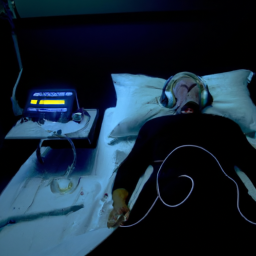Are you tired of the constant buzzing and ringing in your ears, like a never-ending symphony of noise? It’s time to uncover the secrets behind otosclerosis and tinnitus.
Imagine a delicate orchestra conductor, the anatomy of your ear, guiding the complex symphony of sounds that surround you. But when otosclerosis strikes, it’s as if this conductor loses control, causing abnormal bone growth that impairs your hearing.
And as if that wasn’t enough, tinnitus joins the performance, adding its own dissonant notes to the mix. But fear not, for there is hope and treatment options available.
By understanding the causes and risk factors of otosclerosis, as well as the mechanisms behind tinnitus, you can take control of your auditory destiny.
In this article, we will explore the anatomy of the ear, delve into the mysteries of otosclerosis, unravel the enigma of tinnitus, and discover the diagnosis and treatment options that can bring harmony back to your world of sound.
So, grab a seat and get ready for a symphony of knowledge that will change your perception of otosclerosis and tinnitus forever.
Key Takeaways
- Otosclerosis is a condition characterized by abnormal bone growth in the middle ear, leading to hearing loss.
- Tinnitus is the perception of sound in the absence of an external source and can be caused by damage to the hair cells in the inner ear or changes in the brain’s auditory pathways.
- Diagnosing otosclerosis and tinnitus involves a medical history, physical examination, and various tests such as audiometry, tympanometry, and imaging studies.
- Treatment options for otosclerosis include surgical intervention, where the stapes bone is removed and replaced with a prosthesis, or the use of hearing aids to amplify sound and compensate for hearing loss. Management strategies for tinnitus include relaxation techniques, sound therapy, cognitive-behavioral therapy (CBT), and support groups.
Anatomy of the Ear and How It Relates to Otosclerosis and Tinnitus
The anatomy of the ear and its relationship to otosclerosis and tinnitus can be better understood by examining the intricate structures within.
The ear is divided into three main parts: the outer ear, middle ear, and inner ear. The outer ear consists of the pinna and ear canal, which help collect sound waves and direct them towards the middle ear.
In the middle ear, the eardrum vibrates in response to sound, and these vibrations are transmitted to the inner ear through three tiny bones called the ossicles.
The inner ear contains the cochlea, a spiral-shaped structure responsible for converting sound vibrations into electrical signals that can be interpreted by the brain.
Otosclerosis, a condition characterized by abnormal bone growth in the middle ear, can interfere with the transmission of sound and lead to hearing loss. Tinnitus, on the other hand, is often associated with damage to the delicate hair cells in the cochlea.
Understanding the anatomy of the ear is crucial in comprehending the causes and risk factors for otosclerosis, which will be discussed in the next section.
Causes and Risk Factors for Otosclerosis
Contrary to what many may think, there are certain factors that can increase the likelihood of developing otosclerosis. Some of these factors include:
-
Genetic factors: Research suggests that otosclerosis may be inherited, with a family history of the condition increasing the risk of developing it.
-
Hormonal changes: It has been observed that otosclerosis is more common in women, especially during pregnancy or hormonal fluctuations. This suggests a potential link between hormonal changes and the development of otosclerosis.
Other potential risk factors for otosclerosis include a history of measles or viral infections, as well as certain autoimmune disorders. While the exact cause of otosclerosis is still not fully understood, these factors can play a role in its development.
Understanding the mechanisms behind tinnitus, which is often associated with otosclerosis, is crucial for effective treatment.
Understanding the Mechanisms behind Tinnitus
To fully grasp the underlying causes of tinnitus, it’s crucial for you to understand the intricate mechanisms at play. Tinnitus is the perception of sound in the absence of an external source, and it can be a result of various factors.
One mechanism behind tinnitus involves damage to the hair cells in the inner ear, which are responsible for detecting sound waves and transmitting signals to the brain. When these hair cells are damaged, they can send abnormal signals to the brain, leading to the perception of sound.
Another mechanism is related to changes in the brain’s auditory pathways, where the brain becomes more sensitive to certain frequencies or sounds. These mechanisms can have a significant impact on daily life, causing sleep disturbances, concentration difficulties, and even emotional distress.
Understanding these mechanisms is crucial for developing effective treatment options for individuals with tinnitus.
Moving on to the diagnosis and evaluation of otosclerosis and tinnitus…
Diagnosis and Evaluation of Otosclerosis and Tinnitus
Ready to dive into the process of diagnosing and evaluating otosclerosis and tinnitus? Let’s explore how these conditions are identified and assessed! When it comes to diagnosing otosclerosis and tinnitus, doctors utilize a variety of diagnostic tests and tools to gather information and make an accurate assessment. First and foremost, a thorough medical history is taken to understand the patient’s symptoms and any potential risk factors. This is followed by a physical examination, including a detailed examination of the ears. To further evaluate the condition, various tests may be conducted, such as audiometry, tympanometry, and imaging studies like CT scans. These tests help to determine the severity and extent of the condition, as well as rule out any other underlying causes. Once the diagnosis is confirmed, the next step is to explore treatment options for otosclerosis.
Treatment Options for Otosclerosis
When it comes to addressing the issue of otosclerosis, you have a range of treatment options at your disposal, each designed to alleviate the symptoms and improve your quality of life.
One common treatment for otosclerosis is surgical intervention. This can involve removing the stapes bone and replacing it with a prosthesis to restore hearing. Surgery can be highly effective in improving hearing loss caused by otosclerosis.
Another option is the use of hearing aids. These devices can amplify sound and help compensate for the hearing loss associated with otosclerosis. Hearing aids can be particularly beneficial for individuals who aren’t suitable candidates for surgery.
In some cases, a combination of surgery and hearing aids may be recommended.
Now let’s explore management strategies for tinnitus.
Management Strategies for Tinnitus
Explore effective strategies to help you manage the persistent ringing in your ears, providing you with relief and restoring the peace and quiet you deserve. Here are some strategies that have been found to be helpful:
-
Relaxation techniques: Engaging in relaxation techniques such as deep breathing, meditation, and yoga can help reduce stress and promote a sense of calm. This, in turn, can alleviate tinnitus symptoms.
-
Sound therapy: Using external sounds to mask or distract from the tinnitus noise can be beneficial. This can include listening to soft music, white noise machines, or using specially designed tinnitus masking devices.
-
Cognitive behavioral therapy (CBT): CBT can help change the negative thought patterns and emotional responses associated with tinnitus. It allows you to better cope with the condition.
-
Support groups: Connecting with others who are experiencing tinnitus can provide a sense of understanding and support. This can help reduce feelings of isolation and provide valuable tips and advice for managing tinnitus.
By incorporating these strategies into your daily routine, you can find relief from tinnitus and regain control over your auditory experience.
Frequently Asked Questions
Can otosclerosis and tinnitus be completely cured?
Surgery can be an effective option to cure otosclerosis and tinnitus. However, it’s important to note that complete cure may not always be possible. The long-term effects of treatment for otosclerosis and tinnitus can vary depending on the individual. It’s crucial to consult with a healthcare professional to discuss the best treatment plan for your specific case and to understand the potential outcomes and effects of treatment.
Are there any alternative treatments for otosclerosis and tinnitus?
Alternative therapies and natural remedies can provide additional options for managing otosclerosis and tinnitus. While there’s no cure for these conditions, some people find relief through alternative treatments. These may include acupuncture, chiropractic adjustments, herbal supplements, and sound therapy.
It’s important to note that the effectiveness of these treatments varies for each individual, and they should always be used in conjunction with medical advice. Consult with a healthcare professional to explore these alternative options.
Can stress or anxiety worsen the symptoms of otosclerosis and tinnitus?
Yes, stress and anxiety can worsen the symptoms of otosclerosis and tinnitus. Stress management techniques, such as deep breathing exercises and meditation, can help alleviate these symptoms. Research has shown a relationship between otosclerosis and anxiety, with stressors triggering or exacerbating the condition. It is important to manage stress levels to minimize the impact on otosclerosis and tinnitus. Seeking support from a healthcare professional can also provide guidance on effective stress management strategies.
Is there a link between otosclerosis and tinnitus and genetics?
Yes, there’s a link between otosclerosis and tinnitus and genetics. Genetic factors play a role in the development of both conditions. Studies have shown that certain genes can increase the risk of developing otosclerosis and tinnitus.
Additionally, otosclerosis can lead to hearing loss, which can further contribute to the development or worsening of tinnitus. Understanding the genetic basis of these conditions can help in the development of targeted treatment options.
Are there any support groups or resources available for individuals with otosclerosis and tinnitus?
Yes, there are support groups and online resources available for individuals with otosclerosis and tinnitus. Support groups offer a space where you can connect with others who understand what you’re going through. They provide emotional support, share experiences, and offer coping strategies.
Online resources, such as websites and forums, offer information about the conditions, treatment options, and helpful tips. These resources can be valuable in helping you navigate your journey with otosclerosis and tinnitus.
Conclusion
In conclusion, you now have a better understanding of otosclerosis and tinnitus, including their causes and treatment options.
Remember, the anatomy of your ear plays a crucial role in these conditions, so taking care of your hearing health is essential.
While there are various risk factors for otosclerosis, diagnosis and evaluation are crucial for determining the best treatment approach.
And if you’re experiencing tinnitus, don’t worry, there are management strategies available.
So don’t wait, take control of your hearing health and say goodbye to the annoying ringing in your ears!




